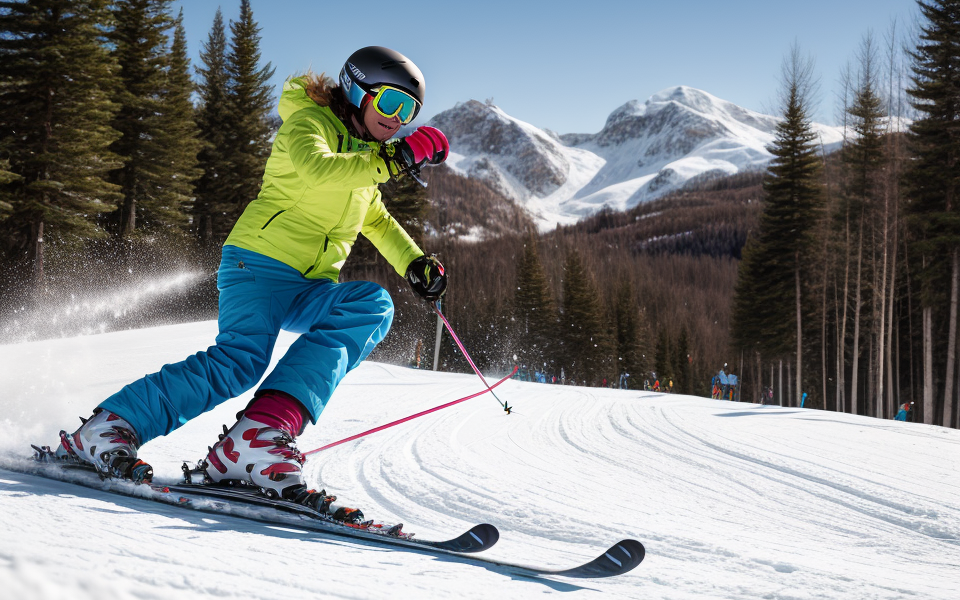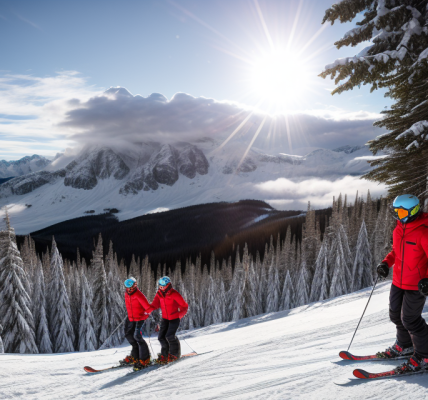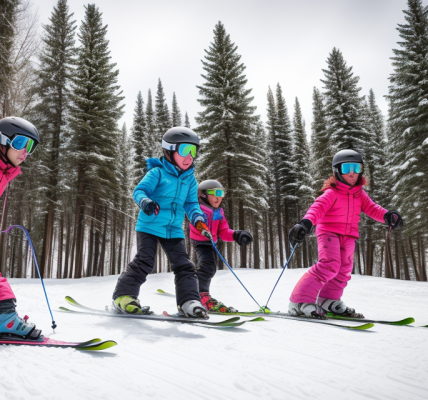Are you ready to hit the slopes and improve your skiing skills? Whether you’re a beginner or an experienced skier, taking ski lessons can help you take your abilities to the next level. But how do you make the most out of your ski lesson experience? In this article, we’ll provide you with some tips and tricks to help you maximize your ski lesson experience and get the most out of your time on the mountain. From warming up properly to communicating effectively with your instructor, we’ve got you covered. So grab your skis and let’s get started!
Preparing for Your Ski Lesson
Setting Expectations
When it comes to maximizing your ski lesson experience, setting expectations is a crucial step. This involves defining your goals for the lesson, discussing your level of skiing and areas for improvement, and clarifying the instructor’s approach and teaching style.
Define Your Goals for the Lesson
Before your ski lesson, take some time to reflect on what you hope to achieve. Are you looking to improve your technique, learn new skills, or simply gain confidence on the slopes? Whatever your goals may be, it’s important to communicate them to your instructor so they can tailor the lesson to your needs.
Discuss Your Level of Skiing and Areas for Improvement
Be honest with your instructor about your current skiing ability and any areas where you struggle. This will help them to identify your strengths and weaknesses and create a personalized lesson plan that focuses on your specific needs.
Clarify the Instructor’s Approach and Teaching Style
Every instructor has their own unique approach and teaching style, so it’s important to clarify what you can expect from your lesson. Ask questions about their teaching philosophy, the structure of the lesson, and any specific techniques or drills they plan to use. This will help you to better understand what to expect during the lesson and how to make the most of your time on the slopes.
Gearing Up
Having the right equipment is crucial for a comfortable and safe skiing experience. It is important to ensure that your equipment fits you properly, as ill-fitting gear can cause discomfort and even injury. When gearing up for your ski lesson, make sure to:
- Properly fitted ski equipment: Ski boots should fit snugly and securely, with a little room for movement. Ski poles should be the appropriate length for your height, and the grip should fit comfortably in your hand. Your skis should be the right length and width for your ability level and skiing conditions.
- Appropriate clothing for the weather conditions: Dress in layers, as temperatures can vary significantly between the ski lift and the slopes. Wear moisture-wicking materials to keep you dry and comfortable, and make sure to bring extra layers in case you get cold. It’s also important to wear sunscreen and sunglasses to protect your skin and eyes from the sun.
- Carrying essentials: snacks, water, and a phone: Make sure to bring snacks and water to keep you fueled and hydrated throughout the lesson. It’s also a good idea to bring a phone or other communication device in case of emergencies.
Maximizing the Lesson Time
Active Listening and Communication
Effective communication is crucial for maximizing your ski lesson experience. Here are some tips for active listening and communication during your ski lessons:
Ask questions and seek clarification
Asking questions is a great way to ensure that you understand the instructions given by your ski instructor. Don’t be afraid to ask for clarification if you’re unsure about something. Your instructor is there to help you, so don’t hesitate to ask for clarification on any aspect of the lesson.
Provide feedback and share your thoughts
Your ski instructor is there to help you improve your skiing skills, so it’s important to provide feedback and share your thoughts during the lesson. Let your instructor know what you’re feeling and what you think you can do better. This will help your instructor tailor the lesson to your specific needs and ensure that you’re getting the most out of the experience.
Be open to constructive criticism
Constructive criticism is an important part of the learning process. Your ski instructor may provide feedback on your technique or suggest areas for improvement. Be open to this feedback and use it to improve your skiing skills. Remember that your instructor is there to help you, so take their feedback seriously and use it to make progress.
By actively listening and communicating with your ski instructor, you can ensure that you’re getting the most out of your ski lesson experience. Remember to ask questions, provide feedback, and be open to constructive criticism, and you’ll be well on your way to becoming a better skier.
Focusing on Technique
Breaking Down Each Skill into Smaller Parts
When it comes to mastering skiing techniques, it’s important to break down each skill into smaller parts. This allows you to focus on one aspect at a time, rather than trying to tackle the entire skill all at once. For example, if you’re working on your parallel turns, you might start by focusing on the body position, then move on to the weight shift, and finally the pole plant.
Practicing with Proper Form and Technique
Proper form and technique are essential for success on the slopes. When practicing a new skill, make sure to pay close attention to your body position, weight distribution, and movement patterns. It can be helpful to use a mirror or have a friend video you from a distance to get a better sense of your form. Remember, it’s better to practice correctly from the start, rather than developing bad habits that will be harder to break later on.
Repetition for Muscle Memory
Repetition is key when it comes to building muscle memory. The more you repeat a particular skiing technique, the more ingrained it becomes in your muscles and brain. This means that you’ll be able to perform the skill more easily and with less conscious thought. However, it’s important to balance repetition with rest and recovery. Over-practicing a skill can lead to fatigue and injury, so make sure to take breaks and allow your muscles time to recover between practice sessions.
Embracing Challenges
Embracing challenges is an essential aspect of maximizing your ski lesson experience. By tackling progressive challenges, you can build your confidence and improve your skiing skills. Here are some tips on how to embrace challenges during your ski lessons:
- Progressive challenges to build confidence: To build your confidence on the slopes, it’s important to start with small, achievable goals and gradually work your way up to more challenging ones. For example, if you’re new to skiing, you might start by learning how to stop and turn on flat terrain. Once you’ve mastered these basic skills, you can move on to more challenging terrain, such as hills or moguls. By setting small, achievable goals, you can build your confidence and feel a sense of accomplishment as you progress.
- Taking calculated risks to improve: While it’s important to be cautious on the slopes, taking calculated risks can also help you improve your skiing skills. For example, if you’re comfortable skiing on blue runs, you might try skiing a black run to challenge yourself and improve your skills. However, it’s important to take calculated risks and never push yourself beyond your limits. Always prioritize safety and ski within your ability level.
- Embracing failure as a learning opportunity: Failure is a natural part of the learning process, and it’s important to embrace it as a learning opportunity. If you don’t succeed at something, don’t get discouraged. Instead, analyze what went wrong and use that experience to improve your skills. For example, if you fall while skiing, take a moment to assess what caused you to fall and how you can prevent it from happening again in the future. By embracing failure as a learning opportunity, you can continue to improve your skiing skills and build your confidence on the slopes.
Post-Lesson Reflection
Reviewing Progress
Assessing Your Performance
After every ski lesson, it is essential to take some time to assess your performance. This includes analyzing your skiing technique, speed, and overall confidence on the slopes. You can ask your instructor for feedback, or you can review the video footage of your lesson to identify areas where you need improvement.
Identifying What Worked and What Didn’t
Once you have assessed your performance, it is important to identify what worked and what didn’t. This can help you understand what techniques are effective and which ones need more practice. For example, if you found it easier to control your speed on the flats, then you know that you need to focus on improving your technique for steeper slopes.
Setting Realistic Goals for the Next Lesson
Setting realistic goals for the next lesson is crucial for continued progress. Based on your assessment of your performance and identification of what worked and what didn’t, you can set specific goals for the next lesson. For example, if you struggled with turning on steep slopes, your goal for the next lesson could be to focus on building muscle memory for the correct turning technique.
Remember, the goal of a ski lesson is not just to learn new techniques but to develop a consistent and efficient skiing style that you can build upon in future lessons. By taking the time to review your progress after each lesson, you can ensure that you are making steady progress towards your skiing goals.
Continuing Education
- Seek out additional resources for improvement: Utilize online tutorials, instructional videos, and articles to reinforce what you’ve learned in your lessons. Websites like SkiSchoolWeb.com and Ski-Lessons.com offer a wealth of information to help you continue your ski education journey.
- Consider private lessons for more personalized instruction: If you found your group lesson to be too large or you simply want more one-on-one attention, consider booking private lessons. This will allow your instructor to focus on your specific needs and goals, enabling you to make faster progress.
- Attend group clinics or workshops: Periodically, ski resorts host group clinics or workshops, which can be an excellent way to hone your skills and learn new techniques. These events are typically led by experienced instructors and often cover specialized topics, such as mogul skiing or ski racing. To find out about upcoming clinics or workshops, keep an eye on your local ski resort’s event calendar or check with the ski school directly.
Sharing Your Experience
Sharing your ski lesson experience with others is a great way to reflect on what you’ve learned and help others who are just starting their ski journey. Here are some ways you can share your experience:
Discuss your lesson with friends and family
Talking about your ski lesson with friends and family is a great way to process what you’ve learned and get their perspective on your progress. You can share your favorite moments, challenges you faced, and what you’re looking forward to learning next.
Share your progress on social media
Social media is a great platform to share your ski lesson experience with a wider audience. You can post photos or videos of your lesson, share your favorite moments, or even offer advice to others who may be starting their ski journey.
Offer advice to others who may be starting their ski journey
If you’re further along in your ski journey, you can offer advice to others who may be just starting out. You can share tips on how to overcome common challenges, recommend ski lessons or ski schools, or even offer to ski with them and provide guidance on the slopes.
Overall, sharing your ski lesson experience with others is a great way to reflect on what you’ve learned, connect with others who share your passion for skiing, and help others who are just starting their ski journey.
FAQs
1. What should I expect during my first ski lesson?
During your first ski lesson, you can expect to be introduced to the basics of skiing, such as how to put on your equipment, how to stand and balance on skis, and how to make turns. Your instructor will likely start with the fundamentals and gradually build on them as you progress. It’s important to remember that everyone learns at their own pace, so don’t be discouraged if you don’t pick up the sport as quickly as others. The most important thing is to have fun and be patient with yourself.
2. How can I make the most of my ski lesson time?
To make the most of your ski lesson time, it’s important to be fully present and focused on what your instructor is teaching you. Try to avoid distractions, such as checking your phone or getting caught up in conversations with other skiers. It’s also helpful to ask questions and seek clarification if you’re unsure about anything. Your instructor is there to help you, so don’t be afraid to ask for guidance or feedback.
3. What should I wear to my ski lesson?
It’s important to dress appropriately for your ski lesson, as being too hot or too cold can be distracting and uncomfortable. Dress in layers, as it can be difficult to predict the temperature on the mountain. Wear warm, moisture-wicking clothing, such as a base layer, fleece, and a waterproof shell. Don’t forget to wear sunscreen and bring a hat and gloves to protect your skin from the sun and cold.
4. How can I improve my skiing skills between lessons?
To improve your skiing skills between lessons, it’s important to practice regularly and focus on specific areas that you want to improve. Try to ski as much as possible, whether it’s at a resort or in the backcountry. Pay attention to your form and technique, and ask for feedback from more experienced skiers. You can also watch skiing videos online or hire a private coach to help you develop your skills.
5. What should I do if I’m feeling discouraged during my ski lesson?
If you’re feeling discouraged during your ski lesson, it’s important to remember that everyone learns at their own pace and that progress takes time. Try to stay positive and focused on your goals, and don’t be afraid to ask for help or feedback from your instructor. It’s also helpful to take breaks and rest when you need to, as skiing can be physically demanding. Remember that the most important thing is to have fun and enjoy the experience.




